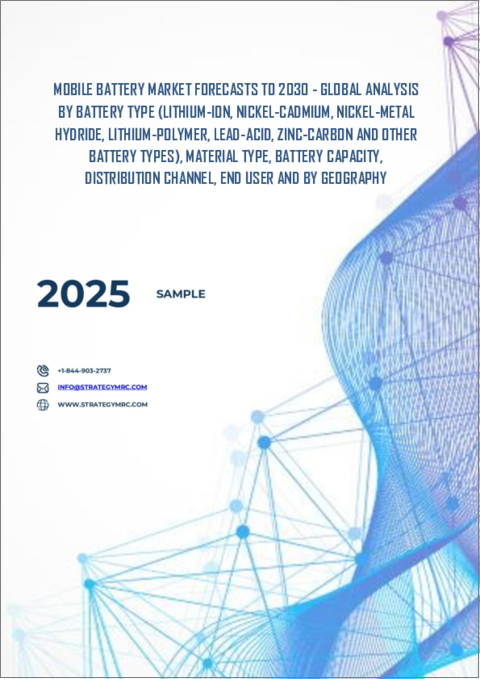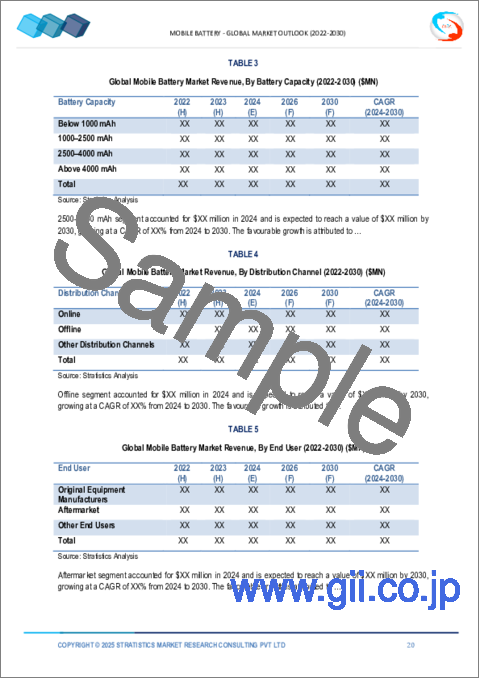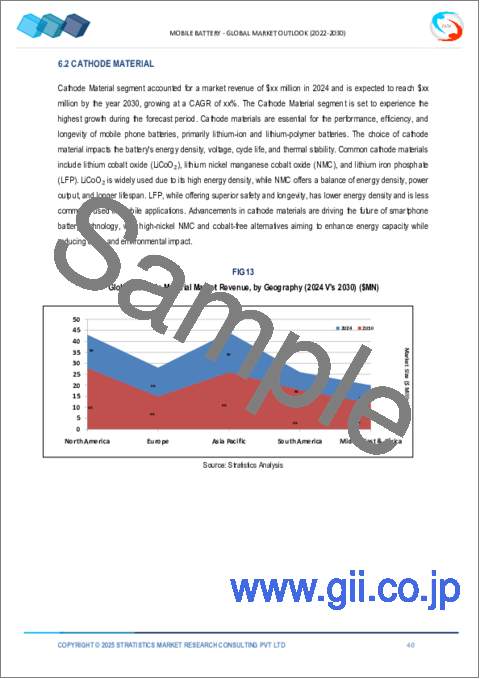|
|
市場調査レポート
商品コード
1569892
モバイルバッテリー市場の2030年までの予測: バッテリータイプ別、材料タイプ別、バッテリー容量別、流通チャネル別、エンドユーザー別、地域別の世界分析Mobile Battery Market Forecasts to 2030 - Global Analysis by Battery Type, Material Type, Battery Capacity, Distribution Channel, End User and By Geography |
||||||
カスタマイズ可能
|
|||||||
| モバイルバッテリー市場の2030年までの予測: バッテリータイプ別、材料タイプ別、バッテリー容量別、流通チャネル別、エンドユーザー別、地域別の世界分析 |
|
出版日: 2024年10月10日
発行: Stratistics Market Research Consulting
ページ情報: 英文 200+ Pages
納期: 2~3営業日
|
全表示
- 概要
- 図表
- 目次
Stratistics MRCによると、世界のモバイルバッテリー市場は2024年に291億6,000万米ドルを占め、2030年には470億5,000万米ドルに達すると予測され、予測期間中のCAGRは8.3%です。
モバイルバッテリーは、スマートフォン、タブレット、ノートパソコン、ウェアラブルデバイスなど、さまざまなモバイル電子機器に電力を供給するために設計されたポータブルエネルギー貯蔵装置です。一般的にリチウムイオンまたはリチウムポリマー技術で構成されるこれらの電池は、高いエネルギー密度、軽量設計、充電可能な機能が特徴です。モバイルバッテリーは操作に必要な電力を供給すると同時に、ユーザーが従来の電源から無メーター状態を維持することを可能にします。
携帯機器の需要拡大
携帯機器に対する需要の高まりは、バッテリー技術と性能の革新を促進することにより、市場に大きな影響を与えます。消費者が日々の活動でスマートフォン、タブレット、ウェアラブル端末に依存するようになるにつれ、より長持ちし、より高速に充電できるバッテリーの必要性が重要になっています。この需要は研究開発の原動力となり、エネルギー密度と効率の向上につながります。さらに、メーカーは持続可能性を強化する必要に迫られ、最終的にモバイルバッテリー業界の将来の情勢を形成しています。
高い製造コスト
高い製造コストは、入手しやすさと手頃な価格を制限することにより、市場に大きな影響を与えます。先端材料や複雑な製造工程に関連する費用は、新規参入を妨げ、技術革新を遅らせる可能性があります。その結果、消費者はデバイスの価格上昇に直面することになり、市場の成長を阻害する可能性があります。さらに、メーカーは持続可能性よりもコスト削減を優先する可能性があり、環境に優しい電池技術の進歩が妨げられるため、市場の成長を阻害します。
電池技術の進歩
バッテリー技術の進歩は、性能、安全性、持続可能性を向上させることで、モバイルバッテリー市場に革命をもたらしています。リチウムイオン、ソリッドステート、急速充電技術などの革新は、エネルギー密度を高め、充電時間を短縮し、より長持ちする電力を求める消費者の需要に応えています。これらの開発により、より幅広い機器にバッテリーを組み込むことも可能になります。さらに、リサイクルと環境に優しい材料への注力は、持続可能な成長と市場競争力強化のための環境問題に対処するものであり、市場の成長を促進するものです。
環境への懸念
環境問題への懸念は、メーカーに対する規制圧力とコンプライアンス・コストを増大させることにより、市場に悪影響を及ぼす可能性があります。電池の廃棄とリサイクルに関する規制が強化されると、運用コストが増大し、新規参入企業の技術革新と市場参入が遅れる可能性があります。さらに、こうした課題によって生産能力が制限され、消費者の価格が上昇し、市場全体の成長が阻害される可能性もあります。
COVID-19の影響
COVID-19の大流行はモバイルバッテリー市場を混乱させ、サプライチェーンの課題と製造の遅れを引き起こしました。リモートワークやオンライン学習時のスマートフォン、ノートパソコン、タブレット端末の需要増加が成長を牽引しました。しかし、変動する原材料価格と物流のハードルが大きな障害となった。デジタル化へのシフトは電池技術の革新を加速させ、効率と持続可能性を主要な市場動向として重視しました。
予測期間中、鉛蓄電池分野が最大となる見込み
予測期間中、鉛蓄電池セグメントが市場シェアを独占すると予想されます。これは、鉛蓄電池の費用対効果とさまざまな温度下での堅牢な性能が、特定の市場にとって魅力的であるためです。しかし、より軽量で効率的なリチウムイオン電池へのシフトにより、鉛電池の優位性は徐々に失われつつあります。環境規制が強化されるにつれて、リサイクルや持続可能な代替品の推進も、モバイル・アプリケーションでの鉛蓄電池使用の再評価を促し、市場全体のダイナミクスに影響を与えています。
4000 mAh以上のセグメントが予測期間中に最も高いCAGRを示す見込み
より優れた性能とより長いバッテリー寿命を持つスマートフォンへの需要の高まりにより、予測期間中、4000mAh超セグメントのCAGRが最も高くなると予想されます。ゲーム、ストリーミング、マルチタスクに対する消費者の需要の高まりを受けて、メーカー各社はモバイル機器に大容量バッテリーを搭載しています。さらに、この動向を後押ししているのは、バッテリー技術の向上と、消費電力が高い5Gスマートフォンの普及です。より大画面でより高性能なプロセッサーが好まれ、市場の成長セグメントを支えています。
最大のシェアを占める地域:
電気自動車の急速な普及により、予測期間中、アジア太平洋地域が最大シェアを占めると予想されます。リチウムイオンバッテリーとソリッドステートバッテリーの技術革新により、性能と安全性が向上しています。同地域の製造能力とコスト面の優位性が世界のプレーヤーを引き付け、競合と技術進歩を促進しています。さらに、環境意識の高まりにより、持続可能な実践と電池リサイクルへの取り組みが推進されています。
CAGRが最も高い地域:
北米地域は、スマートフォン、ウェアラブル、電気自動車の需要増加により、予測期間中に最も高いCAGRで成長すると予想されます。高速充電やエネルギー密度の向上など、バッテリー技術の革新がユーザー体験を向上させています。環境問題への懸念も、持続可能な慣行やリサイクル・イニシアチブの採用を後押ししています。消費者のモバイル機器への依存度が高まるにつれ、市場のさらなる拡大が見込まれ、投資が集まり、バッテリーの効率と寿命の進歩が促進されます。
無料のカスタマイズサービス:
本レポートをご購読のお客様には、以下の無料カスタマイズオプションのいずれかをご利用いただけます:
- 企業プロファイル
- 追加市場プレイヤーの包括的プロファイリング(3社まで)
- 主要企業のSWOT分析(3社まで)
- 地域セグメンテーション
- 顧客の関心に応じた主要国の市場推計・予測・CAGR(注:フィージビリティチェックによる)
- 競合ベンチマーキング
- 製品ポートフォリオ、地理的プレゼンス、戦略的提携に基づく主要企業のベンチマーキング
目次
第1章 エグゼクティブサマリー
第2章 序文
- 概要
- ステークホルダー
- 調査範囲
- 調査手法
- データマイニング
- データ分析
- データ検証
- 調査アプローチ
- 調査情報源
- 1次調査情報源
- 2次調査情報源
- 前提条件
第3章 市場動向分析
- 促進要因
- 抑制要因
- 機会
- 脅威
- エンドユーザー分析
- 新興市場
- COVID-19の影響
第4章 ポーターのファイブフォース分析
- 供給企業の交渉力
- 買い手の交渉力
- 代替品の脅威
- 新規参入業者の脅威
- 競争企業間の敵対関係
第5章 世界のモバイルバッテリー市場:バッテリータイプ別
- リチウムイオン
- ニッケルカドミウム
- ニッケル水素
- リチウムポリマー
- 鉛蓄電池
- 亜鉛炭素
- その他のバッテリータイプ
第6章 世界のモバイルバッテリー市場:材料タイプ別
- カソード材料
- アノード材料
- その他の材料タイプ
第7章 世界のモバイルバッテリー市場:バッテリー容量別
- 1000mAh以下
- 1000~2500mAh
- 2500~4000mAh
- 4000mAh以上
第8章 世界のモバイルバッテリー市場:流通チャネル別
- オンライン
- オフライン
- 小売店
- 家電量販店
- 専門店
- その他の流通チャネル
第9章 世界のモバイルバッテリー市場:エンドユーザー別
- オリジナル機器メーカー
- アフターマーケット
- その他のエンドユーザー
第10章 世界のモバイルバッテリー市場:地域別
- 北米
- 米国
- カナダ
- メキシコ
- 欧州
- ドイツ
- 英国
- イタリア
- フランス
- スペイン
- その他欧州
- アジア太平洋
- 日本
- 中国
- インド
- オーストラリア
- ニュージーランド
- 韓国
- その他アジア太平洋地域
- 南米
- アルゼンチン
- ブラジル
- チリ
- その他南米
- 中東・アフリカ
- サウジアラビア
- アラブ首長国連邦
- カタール
- 南アフリカ
- その他中東とアフリカ
第11章 主な発展
- 契約、パートナーシップ、コラボレーション、合弁事業
- 買収と合併
- 新製品発売
- 事業拡大
- その他の主要戦略
第12章 企業プロファイリング
- A123 Systems
- Amperex Technology Limited(ATL)
- BAK Power Battery
- BYD Company Limited
- Contemporary Amperex Technology Co. Limited(CATL)
- Duracell Inc.
- Energizer Holdings, Inc.
- GS Yuasa Corporation
- Hitachi Chemical Co., Ltd.
- LG Chem Ltd.
- Lishen Battery
- Maxell Holdings, Ltd.
- Murata Manufacturing Co. Ltd.
- Panasonic Corporation
- Samsung SDI Co. Ltd.
- Sony Corporation
- Sunwoda Electronic Co. Ltd.
- Toshiba Corporation
- Varta AG
- Zhuoneng New Energy
List of Tables
- Table 1 Global Mobile Battery Market Outlook, By Region (2022-2030) ($MN)
- Table 2 Global Mobile Battery Market Outlook, By Battery Type (2022-2030) ($MN)
- Table 3 Global Mobile Battery Market Outlook, By Lithium-Ion (2022-2030) ($MN)
- Table 4 Global Mobile Battery Market Outlook, By Nickel-Cadmium (2022-2030) ($MN)
- Table 5 Global Mobile Battery Market Outlook, By Nickel-Metal Hydride (2022-2030) ($MN)
- Table 6 Global Mobile Battery Market Outlook, By Lithium-Polymer (2022-2030) ($MN)
- Table 7 Global Mobile Battery Market Outlook, By Lead-Acid (2022-2030) ($MN)
- Table 8 Global Mobile Battery Market Outlook, By Zinc-Carbon (2022-2030) ($MN)
- Table 9 Global Mobile Battery Market Outlook, By Other Battery Types (2022-2030) ($MN)
- Table 10 Global Mobile Battery Market Outlook, By Material Type (2022-2030) ($MN)
- Table 11 Global Mobile Battery Market Outlook, By Cathode Material (2022-2030) ($MN)
- Table 12 Global Mobile Battery Market Outlook, By Anode Material (2022-2030) ($MN)
- Table 13 Global Mobile Battery Market Outlook, By Other Material Types (2022-2030) ($MN)
- Table 14 Global Mobile Battery Market Outlook, By Battery Capacity (2022-2030) ($MN)
- Table 15 Global Mobile Battery Market Outlook, By Below 1000 mAh (2022-2030) ($MN)
- Table 16 Global Mobile Battery Market Outlook, By 1000-2500 mAh (2022-2030) ($MN)
- Table 17 Global Mobile Battery Market Outlook, By 2500-4000 mAh (2022-2030) ($MN)
- Table 18 Global Mobile Battery Market Outlook, By Above 4000 mAh (2022-2030) ($MN)
- Table 19 Global Mobile Battery Market Outlook, By Distribution Channel (2022-2030) ($MN)
- Table 20 Global Mobile Battery Market Outlook, By Online (2022-2030) ($MN)
- Table 21 Global Mobile Battery Market Outlook, By Offline (2022-2030) ($MN)
- Table 22 Global Mobile Battery Market Outlook, By Retail Stores (2022-2030) ($MN)
- Table 23 Global Mobile Battery Market Outlook, By Consumer Electronics Stores (2022-2030) ($MN)
- Table 24 Global Mobile Battery Market Outlook, By Specialty Stores (2022-2030) ($MN)
- Table 25 Global Mobile Battery Market Outlook, By Other Distribution Channels (2022-2030) ($MN)
- Table 26 Global Mobile Battery Market Outlook, By End User (2022-2030) ($MN)
- Table 27 Global Mobile Battery Market Outlook, By Original Equipment Manufacturers (2022-2030) ($MN)
- Table 28 Global Mobile Battery Market Outlook, By Aftermarket (2022-2030) ($MN)
- Table 29 Global Mobile Battery Market Outlook, By Other End Users (2022-2030) ($MN)
Note: Tables for North America, Europe, APAC, South America, and Middle East & Africa Regions are also represented in the same manner as above.
According to Stratistics MRC, the Global Mobile Battery Market is accounted for $29.16 billion in 2024 and is expected to reach $47.05 billion by 2030 growing at a CAGR of 8.3% during the forecast period. Mobile battery is a portable energy storage device designed to power various mobile electronics, such as smartphones, tablets, laptops, and wearable devices. Typically composed of lithium-ion or lithium-polymer technology, these batteries are characterized by their high energy density, lightweight design, and rechargeable capabilities. Mobile batteries provide the necessary power for operation while enabling users to remain unmetered from traditional power sources.
Market Dynamics:
Driver:
Growing Demand for Portable Devices
The growing demand for portable devices significantly impacts the market by driving innovations in battery technology and performance. As consumers increasingly rely on smartphones, tablets, and wearable's for daily activities, the need for longer-lasting and faster-charging batteries becomes crucial. This demand fuels research and development efforts, leading to advancements in energy density and efficiency. Additionally, manufacturers are compelled to enhance sustainability practices, ultimately shaping the future landscape of the mobile battery industry.
Restraint:
High Manufacturing Costs
High manufacturing costs significantly impact the market by limiting accessibility and affordability. The expenses associated with advanced materials and complex production processes can deter new entrants and slow innovation. Consequently, consumers may face higher prices for devices, which can stifle market growth. Additionally, manufacturers may prioritize cost-cutting over sustainability, hindering eco-friendly advancements in battery technology, thus it hinders the growth of the market.
Opportunity:
Advancements in Battery Technology
Advancements in battery technology are revolutionizing the mobile battery market by improving performance, safety, and sustainability. Innovations such as lithium-ion, solid-state, and fast-charging technologies enhance energy density and reduce charging times, meeting consumer demand for longer-lasting power. These developments also enable the integration of batteries into a wider range of devices. Furthermore, the focus on recycling and eco-friendly materials addresses environmental concerns for sustainable growth and increased competitiveness, thus it drives the growth of the market.
Threat:
Environmental Concerns
Environmental concerns can negatively impact the market by increasing regulatory pressures and compliance costs for manufacturers. Stricter regulations on battery disposal and recycling may lead to higher operational expenses, potentially slowing innovation and market entry for new players. Additionally, these challenges can result in limited production capacity, driving up prices for consumers and hindering overall market growth.
Covid-19 Impact
The COVID-19 pandemic disrupted the mobile battery market, causing supply chain challenges and manufacturing delays. Increased demand for smartphones, laptops, and tablets during remote work and online learning drove growth. However, fluctuating raw material prices and logistical hurdles posed significant obstacles. The shift towards digitalization accelerated innovation in battery technology, emphasizing efficiency and sustainability as key market trends.
The lead-acid segment is expected to be the largest during the forecast period
Over the forecasted timeframe, the lead-acid segment is anticipated to dominate the market share, due to their cost-effectiveness and robust performance in various temperatures make them attractive for specific markets. However, the shift toward lighter, more efficient lithium-ion batteries is gradually diminishing lead-acid's dominance. As environmental regulations tighten, the push for recycling and sustainable alternatives is also prompting a revaluation of lead-acid battery use in mobile applications, impacting overall market dynamics.
The above 4000 mAh segment is expected to have the highest CAGR during the forecast period
The growing demand for smartphones with better performance and longer battery lives is expected to drive the highest CAGR in the above 4000 mAh segment during the forecast period. Higher-capacity batteries are being incorporated by manufacturers into mobile devices in response to the growing demand from consumers for gaming, streaming, and multitasking. Furthermore propelling this trend are improvements in battery technology and the uptake of 5G smartphones, which have higher power consumption. Larger screens and more potent processors are preferred, which helps to sustain the market's growing segment.
Region with largest share:
The Asia Pacific region is expected to hold the largest share of the market during the forecast period due to rapid growth of electric vehicle adoption. Innovations in lithium-ion and solid-state batteries are enhancing performance and safety. The region's manufacturing capabilities and cost advantages attract global players, driving competition and technological advancements. Additionally, rising environmental awareness is promoting sustainable practices and battery recycling initiatives.
Region with highest CAGR:
The North America region is expected to grow at the highest CAGR over the forecast period, owing to increasing demand for smartphones, wearable's, and electric vehicles. Innovations in battery technology, such as faster charging and enhanced energy density, are enhancing user experiences. Environmental concerns are also pushing the adoption of sustainable practices and recycling initiatives. As consumer reliance on mobile devices rises, the market is poised for further expansion, attracting investments and fostering advancements in battery efficiency and lifespan.
Key players in the market
Some of the key players profiled in the Mobile Battery Market include A123 Systems, Amperex Technology Limited (ATL) , BAK Power Battery, BYD Company Limited, Contemporary Amperex Technology Co. Limited (CATL), Duracell Inc., Energizer Holdings, Inc., GS Yuasa Corporation, Hitachi Chemical Co., Ltd., LG Chem Ltd., Lishen Battery, Maxell Holdings, Ltd., Murata Manufacturing Co. Ltd., Panasonic Corporation, Samsung SDI Co. Ltd., Sony Corporation, Sunwoda Electronic Co. Ltd., Toshiba Corporation, Varta AG and Zhuoneng New Energy.
Key Developments:
In August 2024, Hitachi and Gencurix, have entered a strategic partnership in the field of cancer molecular diagnostics. The Partnership aims to develop a testing service for the cancer molecular diagnostics by combining Hitachi High-Tech's core expertise in R&D and manufacturing of in vitro diagnostic products and digital technology.
In August 2024, Hitachi and Singtel Expanded Collaboration to Next-Generation Data Centers and GPU Cloud to Accelerate Enterprise Digital Transformation by AI Adoption.
In May 2024, Panasonic launched new LUMIX S9 compact full-frame mirrorless camera. With this Panasonic aims to bring a new enjoyable shooting experience for creators, making the journey from capturing moments to sharing them with the world.
Battery Types Covered:
- Lithium-Ion
- Nickel-Cadmium
- Nickel-Metal Hydride
- Lithium-Polymer
- Lead-Acid
- Zinc-Carbon
- Other Battery Types
Material Types Covered:
- Cathode Material
- Anode Material
- Other Material Types
Battery Capacities Covered:
- Below 1000 mAh
- 1000-2500 mAh
- 2500-4000 mAh
- Above 4000 mAh
Distribution Channels Covered:
- Online
- Offline
- Other Distribution Channels
End Users Covered:
- Original Equipment Manufacturers
- Aftermarket
- Other End Users
Regions Covered:
- North America
- US
- Canada
- Mexico
- Europe
- Germany
- UK
- Italy
- France
- Spain
- Rest of Europe
- Asia Pacific
- Japan
- China
- India
- Australia
- New Zealand
- South Korea
- Rest of Asia Pacific
- South America
- Argentina
- Brazil
- Chile
- Rest of South America
- Middle East & Africa
- Saudi Arabia
- UAE
- Qatar
- South Africa
- Rest of Middle East & Africa
What our report offers:
- Market share assessments for the regional and country-level segments
- Strategic recommendations for the new entrants
- Covers Market data for the years 2022, 2023, 2024, 2026, and 2030
- Market Trends (Drivers, Constraints, Opportunities, Threats, Challenges, Investment Opportunities, and recommendations)
- Strategic recommendations in key business segments based on the market estimations
- Competitive landscaping mapping the key common trends
- Company profiling with detailed strategies, financials, and recent developments
- Supply chain trends mapping the latest technological advancements
Free Customization Offerings:
All the customers of this report will be entitled to receive one of the following free customization options:
- Company Profiling
- Comprehensive profiling of additional market players (up to 3)
- SWOT Analysis of key players (up to 3)
- Regional Segmentation
- Market estimations, Forecasts and CAGR of any prominent country as per the client's interest (Note: Depends on feasibility check)
- Competitive Benchmarking
- Benchmarking of key players based on product portfolio, geographical presence, and strategic alliances
Table of Contents
1 Executive Summary
2 Preface
- 2.1 Abstract
- 2.2 Stake Holders
- 2.3 Research Scope
- 2.4 Research Methodology
- 2.4.1 Data Mining
- 2.4.2 Data Analysis
- 2.4.3 Data Validation
- 2.4.4 Research Approach
- 2.5 Research Sources
- 2.5.1 Primary Research Sources
- 2.5.2 Secondary Research Sources
- 2.5.3 Assumptions
3 Market Trend Analysis
- 3.1 Introduction
- 3.2 Drivers
- 3.3 Restraints
- 3.4 Opportunities
- 3.5 Threats
- 3.6 End User Analysis
- 3.7 Emerging Markets
- 3.8 Impact of Covid-19
4 Porters Five Force Analysis
- 4.1 Bargaining power of suppliers
- 4.2 Bargaining power of buyers
- 4.3 Threat of substitutes
- 4.4 Threat of new entrants
- 4.5 Competitive rivalry
5 Global Mobile Battery Market, By Battery Type
- 5.1 Introduction
- 5.2 Lithium-Ion
- 5.3 Nickel-Cadmium
- 5.4 Nickel-Metal Hydride
- 5.5 Lithium-Polymer
- 5.6 Lead-Acid
- 5.7 Zinc-Carbon
- 5.8 Other Battery Types
6 Global Mobile Battery Market, By Material Type
- 6.1 Introduction
- 6.2 Cathode Material
- 6.3 Anode Material
- 6.4 Other Material Types
7 Global Mobile Battery Market, By Battery Capacity
- 7.1 Introduction
- 7.2 Below 1000 mAh
- 7.3 1000-2500 mAh
- 7.4 2500-4000 mAh
- 7.5 Above 4000 mAh
8 Global Mobile Battery Market, By Distribution Channel
- 8.1 Introduction
- 8.2 Online
- 8.3 Offline
- 8.3.1 Retail Stores
- 8.3.2 Consumer Electronics Stores
- 8.3.3 Specialty Stores
- 8.4 Other Distribution Channels
9 Global Mobile Battery Market, By End User
- 9.1 Introduction
- 9.2 Original Equipment Manufacturers
- 9.3 Aftermarket
- 9.4 Other End Users
10 Global Mobile Battery Market, By Geography
- 10.1 Introduction
- 10.2 North America
- 10.2.1 US
- 10.2.2 Canada
- 10.2.3 Mexico
- 10.3 Europe
- 10.3.1 Germany
- 10.3.2 UK
- 10.3.3 Italy
- 10.3.4 France
- 10.3.5 Spain
- 10.3.6 Rest of Europe
- 10.4 Asia Pacific
- 10.4.1 Japan
- 10.4.2 China
- 10.4.3 India
- 10.4.4 Australia
- 10.4.5 New Zealand
- 10.4.6 South Korea
- 10.4.7 Rest of Asia Pacific
- 10.5 South America
- 10.5.1 Argentina
- 10.5.2 Brazil
- 10.5.3 Chile
- 10.5.4 Rest of South America
- 10.6 Middle East & Africa
- 10.6.1 Saudi Arabia
- 10.6.2 UAE
- 10.6.3 Qatar
- 10.6.4 South Africa
- 10.6.5 Rest of Middle East & Africa
11 Key Developments
- 11.1 Agreements, Partnerships, Collaborations and Joint Ventures
- 11.2 Acquisitions & Mergers
- 11.3 New Product Launch
- 11.4 Expansions
- 11.5 Other Key Strategies
12 Company Profiling
- 12.1 A123 Systems
- 12.2 Amperex Technology Limited (ATL)
- 12.3 BAK Power Battery
- 12.4 BYD Company Limited
- 12.5 Contemporary Amperex Technology Co. Limited (CATL)
- 12.6 Duracell Inc.
- 12.7 Energizer Holdings, Inc.
- 12.8 GS Yuasa Corporation
- 12.9 Hitachi Chemical Co., Ltd.
- 12.10 LG Chem Ltd.
- 12.11 Lishen Battery
- 12.12 Maxell Holdings, Ltd.
- 12.12 Murata Manufacturing Co. Ltd.
- 12.14 Panasonic Corporation
- 12.15 Samsung SDI Co. Ltd.
- 12.16 Sony Corporation
- 12.17 Sunwoda Electronic Co. Ltd.
- 12.18 Toshiba Corporation
- 12.19 Varta AG
- 12.20 Zhuoneng New Energy





